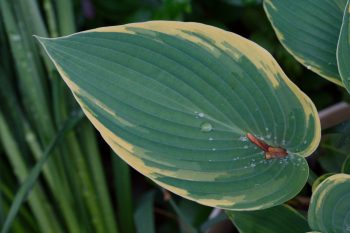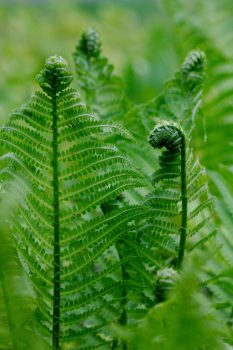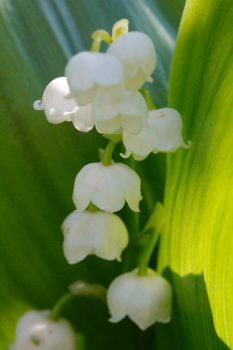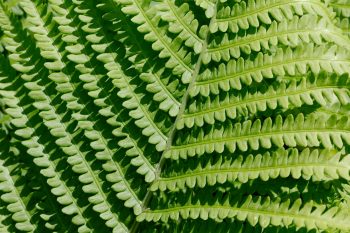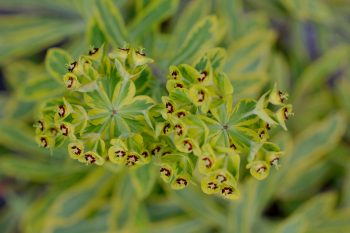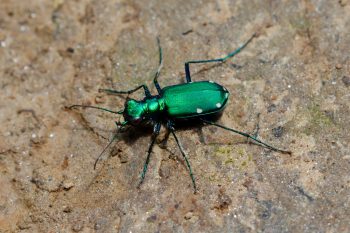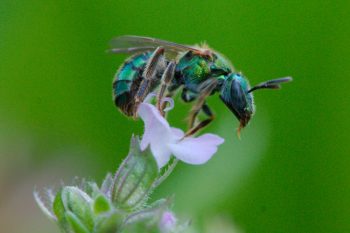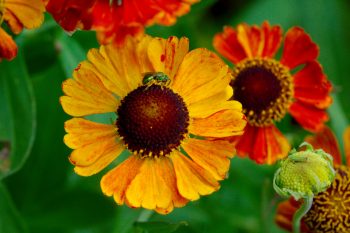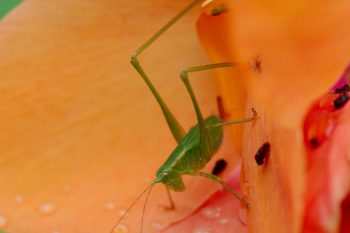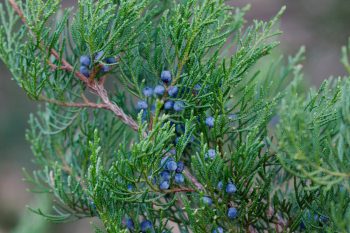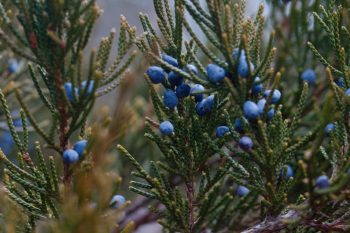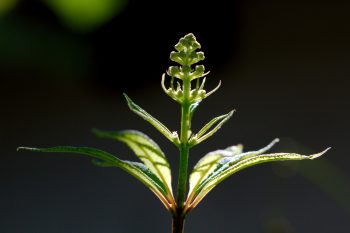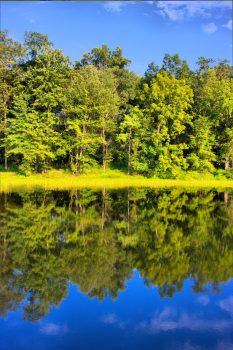Cathy bought a couple hosta plants last year and put them in a container in the front of our house. If we grow them quite close to the house they do reasonably well but the deer and rabbits really seem to like them and if they are farther from the house, they get eaten. Of course the slugs are just about as likely to get them close to the house, but they don’t consume an entire plant over night. This one, called ‘First Frost’, is one of the two that are in this container and it such a pretty little things.
Tagged With: Green
Hosta Leaf
Frond of Ferns
I’ve used the joke before but it’s true, I’m fond of fern fronds. We have a few different ferns in the yard. There is the northern maidenhair fern (Adiantum pedatum, featured seven times so far, apparently), Japanese painted fern (Athyrium niponicum var. pictum), ostrich fern (Matteuccia struthiopteris), and sensitive fern (Onoclea sensibilis). This is, I believe, a Dryopteris species, but I need to do some work if I’m going to identify it for sure. The genus is generally known as the wood ferns but some species have particular names, like male fern (D. filix-mas, which is what I suspect this is) or buckler fern.
The other species this might be, and perhaps it’s more likely based on size, is the lady fern (Athyrium filix-femina). Both the male fern and lady fern are native and both are nice for a shady garden. I really should figure out which this is because every time I’m asked, I have to qualify my answer. A fern expert could probably look at my photo and tell me right off, but I need to look up the differences and look more carefully. If and when I do that, I’ll update this post.
Lily of the Valley (Convallaria majalis)
I know I’ve already had a picture this spring of the lily of the valley (Convallaria majalis) from our garden but it’s blooming so well and so long that I thought I’d share another. We’re also in a little lull where there isn’t a lot new coming out, although it’s still changing. So, here’s another view of the little white bells of the lily of the valley, this time from the back garden, near the fence (not that it makes much difference, of course). Soon the flowers will be gone and even the leaves will fade in the coming heat of summer. We are near the southern limit of where it grows well. If you grow it here, it needs some shade to protect it from the heat of the summer sun but further north it does well in full sun.
We also have a terrific crop of Canadian thistle (Cirsium arvense) coming up among it (and many other places, as well) and it really needs to be dealt with. That’s a really problematical weed, having “a deep and wide-spreading root system with a slender taproot and far-creeping lateral roots.” (Source: Fire Effects Information System, US Forest Service). That same document also says that “new plants can also form from root fragments as short as 0.2 inch (6 mm),” which helps explain why it’s so hard to get rid of.
Woodwardia Frond
I’ve had a few fern photos this spring but here’s another. This is a Woodwardia of some type but I’m not sure which. It’s growing in our shade garden at the north end of our front yard and is quite happy there. We went to the garden center today and I bought a royal fern (Osmunda regalis) to plant in this part of the garden. My thought is to move the Japanese painted fern (Athyrium niponicum var. pictum) to the front of the bed, because it’s too short to be seen well where it is. The royal fern should be plenty tall so that will be nice. It’s something I’ve wanted a while.
Euphorbia amygdaloides subsp. robbiae (Wood Spurge)
I took a few more pictures of plants on Cathy’s work table today. This one is a spurge called Euphorbia amygdaloides subsp. robbiae, also known as Robb’s wood spurge. It’s a nice combination of greens and yellows and something nice for the herbaceous border. The Euphorbia genus has something like 2,000 species and they range from small annual plants to trees and there are species from many parts of the world This one isn’t native to North America, but I’m not bothered by that. One thing you want to be careful of with these plants is their milky sap, which is poisonous if ingested and a skin irritant.
Cicindela sexguttata (Six-spotted Tiger Beetle)
Cathy and I went on a new trail today. I don’t know if the trail is actually new but it was new to us. We walked in the Rock Creek valley between Muncaster and Muncaster Mill Roads. As the crow flies, it’s probably a mile from end to end. The trail winds quite a bit and there’s a bit of up and down and based on a map we found, it’s more like 2.5 each way. So, about five miles. It was pretty hot and very humid, but we really enjoyed the green and also the birds that were supplying the background chorus most of the way. We saw quite a few of these six-spotted tiger beetles (Cicindela sexguttata) as well as ebony jewelwings (Calopteryx maculata), a damselfly with black wings (except for on females there is a conspicuous white spot at the end of the wings.
Green-Sweat Bee
I was out with my macro on a 25mm extension tube this evening and got a few decent photos of this green bee. I labeled it a cuckoo wasp at first, but now I’m thinking it’s a green-sweat bee (Tribe Augochlorini). But don’t hold me to that. If I get a better identification, I’ll update this post. For now, all I can say for sure is that it’s a bee (Anthophila). I can also say that it’s quite pretty. It was moving around quit a bit and this was the best I could do at ISO 800, f/8, 1/100 second.
Sneezeweed (Helenium ‘Mardi Gras’)
Cathy bought a few perennials over the weekend and I planted this one yesterday. It’s a sneezeweed called ‘Mardi Gras’ and it’s really nice. The flowers have a similar look to black-eyed Susans but it’s a different genus (Helenium). I happened to catch it with a little, green-sweat bee on it, which is a bonus. It prefers somewhat barren ground and isn’t supposed to do well in heavy clay, which is probably why I haven’t seen it around here. That’s really all we have. But hopefully it will survive, even if it doesn’t thrive too well.
Scudderia Nymph
I noticed this bright green katydid nymph on the canna lily this morning. It is one of the Scudderia species. It let me get pretty close, as you can see and it actually stayed there for a few days and ate a good amount of the petals on this flower. Generally I’m not a fan of flower-eating insects but this one was pretty enough and eating slowly enough that I let it be. I like the green against the orange of the petals and even though it’s a small thing, I could see it clearly from our kitchen door, which was nice.
Christmas Fern (Polystichum acrostichoides)
Cathy and I took a walk on the west side of Lake Frank after work today. The heavy rain we had yesterday meant that the water level was high, but the trail wasn’t too muddy. We enjoyed being in the woods, hearing the birds, frogs, and insects, and being away from traffic and people. We saw large patches of partridge berry (Mitchella repens), which we hadn’t notice there before. Today’s photo, though, is of the ubiquitous Christmas fern (Polystichum acrostichoides), a common perennial in our woods.
Juniper Berries
Cathy and I went for a walk late today at the Blue Mash Trail behind the Laytonsville land fill. It’s a nice, easy walk and we enjoyed the fall color still showing on a few trees. There is a fair amount of oriental bittersweet (Celastrus orbiculatus), which is pretty, even if it is a bit invasive. There’s a small group of American persimmon trees (Diospyros virginiana) but not much fruit was left at this point. This photo is of juniper berries and leaves. I particularly like this color combination. It’s especially rich on an overcast day like we had this afternoon.
Juniper Leaves and Berries
One of my favorite color combinations is the blue of juniper berries and the green of their leaves. I especially like it on an overcast day, when the colors are more vivid. Either color on its own is attractive and in the running for a favorite color, but the combination is especially nice.
Cathy, Dorothy, and I went for a walk on the Blue Mash Trail this afternoon and that’s where this photo was taken. As usual, it was nice to be out in the woods and meadows for a while and we always have plenty to talk about.
Eutrochium purpureum (Joe Pye Weed)
I stopped at the Croyden Creek Nature Center on the way home, figuring there might be something to photograph there. The swamp milkweed (Asclepias incarnata) was just starting to bloom and I took a few pictures of that with bees on it. Around the other side of the nature center there was some Joe Pye weed (Eutrochium purpureum) coming up. It’s a native, herbaceous perennial and I find it sort of humorous that garden centers actually are able to sell it, since it grows wild around here. I don’t know who Joe Pye was but I’ve seen one story that he was a Native American medicine man who used the plant for various treatments. Anyway, I was attracted to the symmetry of the leaves and the way the light was shining on them at the top of the stem.
The Pond
We were at the farm today with Dorothy and her crew. Their non-profit had two residents the last two weeks and we went up to help them celebrate the end of that. One thing I did that I’ve been meaning to do for a while is identify a bunch of the trees that dad planed in the picnic field. I took latitude and longitude readings on my phone and wrote down the species (if I knew it) or an identifying name and corresponding photographs for those I wasn’t so sure about. I’ll need to come back with a key to the oaks for a couple of them, although I knew more of them than I expected. I’m hoping to make metal tags with information about the trees so this exercise doesn’t have to be repeated.
Later in the day I took this HDR photo of the pond. The color is a little more intense that reality, but it was a very pretty day.

